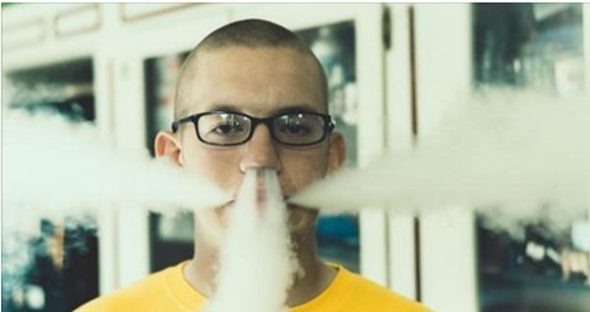Does Vaping Cause Lung Disease? | New Study Raises Concerns
I thought vaping was supposed to help PREVENT lung disease. Now a new study from Great Britain suggests that vaping is not as innocent as simply inhaling water vapor. Vaping lung disease is a real concern.
thoraxjnl-2018-211663.fullThe article looked at the lung function of a dozen or so individuals that vape in order to determine the likelihood for vaping lung disease to be created by the vaping process rather than just by exposure to the e-cigarette liquid. The scientists took some alveolar macrophages (important cells the help keep your lungs healthy and clean) and treated some with unvaped e-cigarette liquid (ECL) and treated others with e-cigarette vapor condensate (ECVC). Interestingly, the scientists showed that the process of turning the liquid into vapor created an intense and destructive effect on the lung cells. It wasn’t even close – there is no question that in this in vitro (the experiment happened in a lab, under a microscope, not inside humans) study the lung cells exposed to the vaped liquid became injured much faster and died quicker than those lung cells just exposed to the liquid. The conclusions of the scientists are ominous: “ECVC is significantly more toxic to AMs than non-vaped ECL. Excessive production of ROS, inflammatory cytokines and chemokines induced by e-cigarette vapour may induce an inflammatory state in AMs within the lung that is partly dependent on nicotine. Inhibition of phagocytosis also suggests users may suffer from impaired bacterial clearance. While further research is needed to fully understand the effects of e-cigarette exposure in humans in vivo, we caution against the widely held opinion that e-cigarettes are safe.”
This is a major a concern given the popularity of Juul and all the other vaping devices. A recent article from the New Yorker really opened my eyes to the ubiquity of Juul – its a real phenomenon among millenials, young people and older people trying to quit regular cigarettes, putting an entire generation at risk for vaping lung disease. According to the article: “An analyst at Wells Fargo projects that this year the American vaporizer market will grow to five and a half billion dollars, an increase of more than 25 per cent from 2017. In the latest data, sixty per cent of that market belongs to Juul.” The Juul vaporizers retail for $34.99 and the four-pack of pods cost $15.99. Very affordable way to get your nicotine rush, especially if you are in high school.
From the Juul website: How does a JUUL pod work? JUUL uses a closed loop temperature control algorithm designed to deliver the ideal amount of power at any given time to the JUULpod. The liquid is heated using an industry standard wick and nichrome coil system. What is the nicotine concentration? Each JUULpod is designed to contain approximately 0.7mL with 5% nicotine by weight (approx. 40 mg per pod based upon 59 mg/mL) at time of manufacture. One JUULpod is intended to replace 1 pack of cigarettes, with ~200 puffs. However, individual smoking and vaping patterns may vary and nicotine content may decrease over an extended period of time. How many cigarettes = 1 pod? One JUULpod is intended to replace 1 pack of cigarettes, with ~200 puffs. However, individual smoking and vaping patterns may vary and nicotine content may decrease over an extended period of time. The Juul website doesn’t mention anything about possible vaping lung disease related to use of Juul.
E-cigarettes, like the Juul have been very helpful for the 70% of American smokers say that they want to quit. But, according to a 2017 study by the C.D.C., about 50% per cent more high schoolers and middle schoolers vape than smoke. Young people have taken a technology that was supposed to help grownups stop smoking and invented a new kind of bad habit, one that they have molded in their own image. Make no mistake – the young people are using the Juul and other vaping technologies to get high. The potential public health benefit of the e-cigarette is being eclipsed by the unsettling prospect of a generation of children who may really love to vape and by doing so, become addicted to the nicotine in the vape fluid.

Vaping may or may not cause “popcorn lung” depending on the presence of diacetyl in the e-cigarette liquid.
E-cigarette use has been linked to another vaping lung disease – something called “popcorn lung” or bronchiolitis obliterans. The American Academy of Pediatrics is particularly concerned about this, so much so that they joined the American Lung Association in suing the FDA for failing to police the vaping industry to keep a chemical called diacetyl out of the e-cigarette liquids. Juul’s e-cigarette liquid doesn’t contain any diacetyl – it actually only has five ingredients – glycerol, propylene glycol, nicotine, benzoic acid, and food-grade flavoring. Glycerol is a sweet liquid that had been used in antifreeze a long time ago before being replaced with ethylene glycol, which has a lower freezing point and is more useful as an antifreeze, but it gave rise to the urban legend that e-cigarettes contain antifreeze. Glycerol is also used in toothpaste, mouthwash, skin care products and a host of other household products. Propylene glycol is used in asthma nebulizers and is present in hundreds of different medications routinely given intravenously as a stabilizer. Benzoic acid is a common food preservative.
Compare those five ingredients with the more than 600 ingredients in regular cigarettes. E-cigarettes seem like they are safer, but as we learn more about the hazards of the vape delivery system, concern that vaping causes lung disease almost to the same degree as tobacco is growing.








































